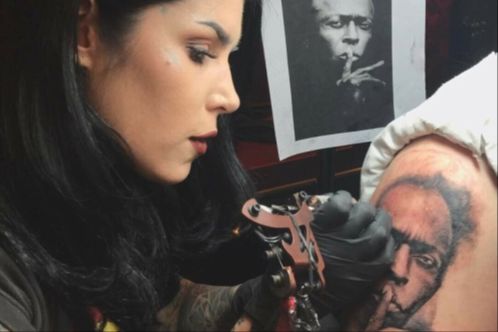A federal jury1 in California found on January 26, 2024, that TV-famous tattoo artist Katherine Von Drachenberg (Kat Von D) did not infringe plaintiff Jeffrey Sedlik's copyrighted photo of jazz artist Miles Davis. Kat Von D did not dispute that she used Sedlik's photo as a reference2 for a tattoo she performed on a friend. The jury decided that Kat Von D's inked rendering of the jazz artist was not substantially similar to Sedlik's portrait, and Sedlik's portrait in social media posts was covered by the fair use doctrine.
How It Started
Sedlik is a professor3 who conducts workshops on copyright and licensing for artist groups and has testified before Congress on such policies and legislation. In 1989, Sedlik took a photo of famous jazz musician Miles Davis, which was published in a magazine that same year.
Fast forward to February 2021, and Jeffrey Sedlik sued Kat Von D and her tattoo parlor, High Voltage Tattoo, in the U.S. District Court for the Central District of California for copyright infringement of this photograph. Kat Von D is known to those who watched the reality show "L.A. Ink" and has a large social media following. In 2017, Kat posted an Instagram photo (below) that depicts her tattooing Miles Davis' portrait on her friend, Blake Farmer—who was not a party to the case—with Sedlik's portrait of the jazz artist in the background.

The photo was then shared on other forms of social media. Sedlik's complaint even cited an online video where Kat is seen using a light table to lay tracing paper over the portrait and then transfer or trace the portrait by pencil. This technique is commonly used in tattoo sketching and preparation.
When the Court Pressed Pause
The parties filed motions in limine, including motions to exclude testimony. The court's series of findings4 in connection with these motions may counsel in other copyright infringement cases involving tattoos:
- The description of how a tattoo was inked is not relevant to whether Kat Von D copied the portrait.
- It is common knowledge that tattoos are a form of personal expression, and this knowledge is not admissible as expert testimony because it is not helpful to the jury.
- Tattoos have inherently distinct meanings that are personal and contextual.
- The process of tattooing requires artistic skills and techniques different from photography.
- The personal meaning of a tattoo that a customer may ascribe to their tattoo is irrelevant to infringement.
- The custom or practice of the tattoo industry is only admissible for the issue of willfulness but not admissible for other factors of the fair use defense inquiry.
On November 21, 2022, the court issued a stay in light of the U.S. Supreme Court's decision in Andy Warhol Foundation for the Visual Arts, Inc. v. Goldsmith.
The circumstances in Warhol were relevant to the issues at play in Sedlik v. Kat Von D. At a high level, the issue in Warhol was whether Andy Warhol's "Orange Prince"—an image of the musician Prince—that was indisputably based on photographer Lynn Goldsmith's magazine cover was fair use. The Supreme Court evaluated only the first (of four) fair use factors and explained that a work's "commercial" nature does not automatically render the use unfair, although it is relevant. Ultimately, the Court ruled that the fair use doctrine did not apply because both Warhol and Goldsmith's images shared substantially the same commercial purpose. After the Supreme Court issued its decision against Warhol, Judge Fischer lifted the stay in Sedlik in May 2023.
Hitting Play
At trial, Kat Von D testified that the tattoo industry does not have a practice of seeking licenses, explaining that "nobody ever asks for permission5" for copyrighted works, and compared tattoos to "fan art6." She did not seek compensation7 for her tattoo or generate revenue from her social media posts of the tattoo or process. As indicated above, this argument was likely to distinguish her case from Warhol and show that the purpose behind her tattoo was neither commercial nor the same as Sedlik's purpose behind photographing Miles Davis.
Sedlik proposed a "hypothetical-license damages8 " position based on the amount a willing buyer would have reasonably been required to pay a willing seller at the time of infringement for the actual use made by the infringer of the plaintiff's work. He did not seek specific damages and did not present a damages expert.
After a two-hour deliberation, the jury found that fair use protected the social media posts of the tattoo and that the tattoo was not substantially similar to the Sedlik's portrait. On January 30, 2024, Judge Fischer entered9 judgment that a jury rendered a verdict in favor of Kat Von D, ordered that Sedlik take nothing, dismissed the action on the merits with prejudice, and granted the defendants' recovery of the "cost of suit" under 28 U.S.C. § 1920, which largely includes filing fees.
Takeaways
While many tattoo parlors, artists, and customers with ink on their skin are relieved over the legality and safety of their pieces, ongoing considerations remain for the intersection of copyright law and tattoos.
First, the jury decided this case on "substantial similarity," finding that the tattoo was not substantially similar to the portrait, measured10 by the total concept and feel of the works and a particular combination, selection, or arrangement. Without a written opinion, litigators are limited as to understanding how the works were different or what arguments were successful. Nevertheless, one can imagine cases where a tattoo is substantially similar to a photograph or even an iconic font.
Second, most tattoos are inked for a fee, unlike in this case, which benefits both the artist and the tattoo parlor. This could implicate the first fair use factor, which asks about the "commercial nature" of using another's work. This is the strongest defense in copyright law, so artists typically plead it and structure their case around the factors.
Third, while Kat Von D is the sole owner and/or majority owner of High Voltage Tattoo, Inc., which was sued in this case, other tattoo parlors may have several owners or arrangements with artists as independent contractors. These business arrangements have practical implications on tattoo fees, as well as downstream considerations of damages in an infringement case where they are pled. Sedlik used a hypothetical license fee model, but future copyright owners and litigators may choose more concrete actual damages, including the cost of the tattoo, revenue generated from the tattoo (where the facts support it), or statutory damages.
Finally, these issues could be revisited if Sedlik seeks an appeal or files a motion to set aside the judgment.
Footnotes
1. Craig Clough, Kat Von D's Miles Davis Tattoo Didn't Infringe Photo, Jury Says, Law360 (Jan. 26, 2024).
2. Defendants' Amended Memorandum of Contentions of Fact and Law, Sedlik v. Drachenberg, ECF. No. 156, Case No. 2:21-cv-01102 (C.D. Cal. 2023).
3. Complaint, Sedlik v. Drachenberg, ECF. No. 1, Case No. 2:21-cv-01102 (C.D. Cal. 2021).
4. Sedlik v. Drachenberg, Order Granting in Part and Denying in Part Motion to Exclude, 2022 WL 17886029, at *2-4 (C.D. Cal. June 27, 2022).
5. Clough, 'Nobody' Gets Photo Licenses For Tattoos, Kat Von D Testifies, Law360 (Jan. 24, 2024).
6. Craig Clough, Will Kat Von D Trial Have A 'Blurred Lines' Impact On Tattoos?, Law360 (Jan. 25, 2024).
7. Defendants' Amended Memorandum of Contentions of Fact and Law, Sedlik v. Drachenberg, ECF. No. 156, Case No. 2:21-cv-01102 at 10 (C.D. Cal. 2023).
8. Sedlik v. Drachenberg, Plaintiff's Resp. and Obj. to Defendants. Trial Brief at 2-3 (C.D. Cal. Jan. 23, 2024).
9. Judgment, Sedlik v. Drachenberg, ECF. No. 224, Case No. 2:21-cv-01102 (C.D. Cal. 2024).
10. Jury Instructions, Sedlik v. Drachenberg, ECF. No. 219, Case No. 2:21-cv-01102 (C.D. Cal. 2024).
The content of this article is intended to provide a general guide to the subject matter. Specialist advice should be sought about your specific circumstances.


